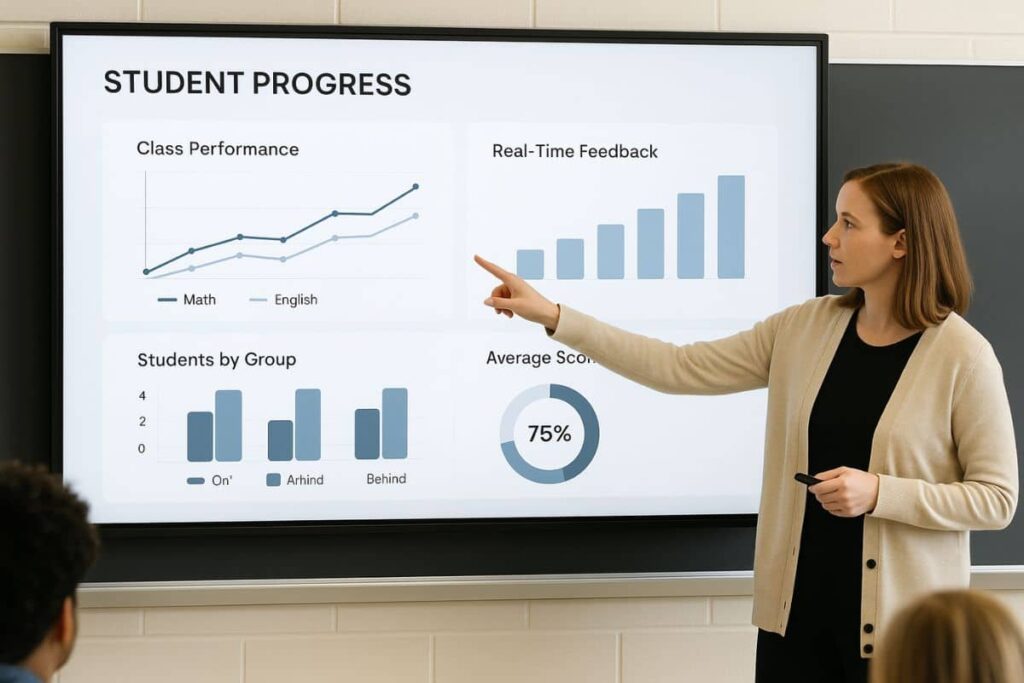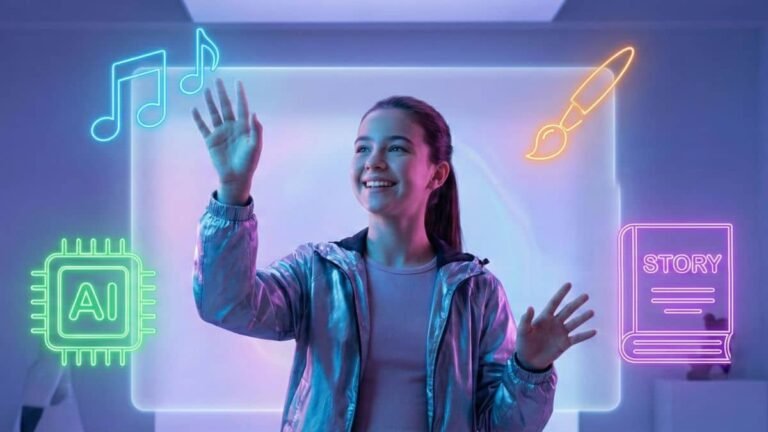Address
251 Little Falls Drive, Wilmington, DE 19808, United States

Could artificial intelligence be your child’s next teacher? In 2025, AI tools in school are transforming the way students learn, create, and think. From instant tutoring to smart lesson planning, schools are moving fast. This article explores the AI tools that are reshaping education right now. Ready to see what’s changing?
Table of Contents
Why AI integration in classrooms is no longer optional
It’s 2025, and artificial intelligence is no longer a futuristic dream, it’s part of your child’s daily school life. From lesson planning to real-time tutoring, AI tools in classrooms are now a core part of modern education. Schools that ignore this shift risk falling behind, both in engagement and academic performance. The question is no longer if AI should be used, it’s how well we use it.
The surprising benefits of AI tools in school for young learners
At first glance, AI might seem too advanced for young students. But in reality, the right tools are making learning more personal, interactive, and exciting. Children are receiving instant feedback, adaptive challenges, and even emotional support through AI. It’s like having a second teacher, one that never sleeps and adjusts to every child’s pace. This evolution is why AI learning for kids has become a priority for schools around the world.
Introducing Khanmigo: Khan Academy’s AI tutor for kids
Khan Academy, known for revolutionizing online learning, has launched Khanmigo, an AI-powered tutor designed specifically for children. It doesn’t just deliver content, it interacts like a patient, encouraging teacher.
Personalized Learning with Instant Feedback
With Khanmigo, students can ask questions in natural language and receive clear, guided responses. Whether a child struggles with fractions or needs a nudge in reading comprehension, Khanmigo provides real-time support tailored to their level.
How Teachers Use Khanmigo in Real-Time Lessons
Teachers use Khanmigo to assign exercises, monitor student progress, and even facilitate small group discussions. It saves hours in grading and lesson planning, freeing educators to focus on high-touch teaching moments.

How Scratch with AI Extensions Sparks Creative Coding for Kids
Scratch with AI extensions has turned the classic drag-and-drop coding platform into an imaginative space powered by artificial intelligence. This tool isn’t just for tech whizzes, it’s for every kid with a story to tell or a game to build.
From basic blocks to intelligent bots
Children now use Scratch to code chatbots, build AI-driven games, and simulate smart environments. AI features introduce concepts like natural language processing or facial recognition in a safe, kid-friendly interface.
Building problem-solving skills through AI play
By experimenting with AI logic, students improve their critical thinking and learn to troubleshoot in real time. They’re not just consuming tech, they’re shaping it.
Using Diffit to turn any text into a kid-friendly lesson plan
Diffit is a powerful tool that takes any complex article, document, or text and converts it into simplified versions tailored for young readers. This isn’t just about summarizing, it’s about adapting content without losing depth.
Customizing complexity without losing meaning
Teachers can input a news article or historical document, and Diffit will instantly generate leveled reading versions, vocabulary aids, and comprehension questions. It’s like having an on-demand curriculum specialist.
Real classroom examples with Diffit
In one 5th grade classroom, a teacher used Diffit to turn a New York Times editorial into a 3-paragraph persuasive reading exercise. Students felt empowered to debate adult topics in language they could grasp.
How AI tools support special education needs
One of the most promising uses of AI tools in school is in special education. Students with learning disabilities often require differentiated instruction, and AI can deliver it consistently and instantly. Tools like speech-to-text, predictive spelling, and adaptive pacing ensure that no student is left behind due to a rigid curriculum.
Personalized support for learning disabilities
AI platforms can recognize patterns in student responses and adjust the difficulty level, timing, or delivery of content to match individual needs. This is especially helpful for students with ADHD, dyslexia, or processing disorders who may struggle with traditional instruction methods.
AI-powered speech & language assistance
Text-to-speech engines and real-time voice transcription tools empower students with language or speech delays. These tools offer independence and dignity, letting students participate actively without the need for constant one-on-one support.
Real teachers share how AI changed their classrooms
Technology only works when real people use it meaningfully. Educators across the globe are sharing how AI has enhanced, not disrupted, their teaching practice. The difference is often in the small details: faster feedback, more engaged learners, and fewer behavior issues.
A 3rd grade teacher’s story using Diffit
“I used Diffit to turn a dense science article into three reading levels for my class,” says Ms. Grant, a third-grade teacher in Ohio. “My struggling readers felt included in the discussion for the first time. That moment changed the energy in my classroom.”
How AI encourages independent learning
One of the most powerful impacts of AI tools in school is how they foster independent learning habits. Rather than waiting for teacher instructions, students can now explore topics at their own pace, revisit difficult concepts, and receive immediate feedback, all without raising a hand.
Platforms like Khanmigo and personalized learning systems offer adaptive content that shifts in difficulty based on student performance. This empowers students to own their progress, set goals, and work through challenges with minimal external pressure.
Teachers have reported that students using AI consistently show greater confidence in asking questions, experimenting with new formats, and reflecting on their learning journey. These habits not only improve academic results—they prepare students for lifelong learning outside the classroom walls.
Gamification in AI tools: Making learning fun
Gamification, turning learning into a game, isn’t a new concept, but AI has taken it to a new level. Today’s AI-powered tools embed points, badges, levels, and friendly competition directly into the educational experience, transforming how kids interact with content.
Scratch with AI extensions lets students build games while learning logic and language. Khanmigo rewards progress and encourages reflection with prompts like, “Want to try a challenge at a higher level?” Even Diffit makes comprehension checks feel like digital puzzles rather than pop quizzes.
More importantly, gamification taps into intrinsic motivation. Children become excited to “level up” their understanding rather than simply chase grades. AI ensures that rewards are personalized and timed to keep engagement high without overwhelming students.
Gamified AI also supports shy or hesitant learners. When tasks feel like a game, students are more willing to take risks, fail safely, and try again: key components of real learning.
How parents can engage with AI learning at home
AI doesn’t stop at the school gate. Many tools now offer family-facing dashboards that allow parents to track progress and understand how their child is learning. Informed parents can better support homework, reading time, or digital exploration at home.
Monitoring progress through AI dashboards
Platforms like Khanmigo and Diffit provide insights into what a student is struggling with or excelling in. These dashboards show trends over time, enabling parents to work alongside teachers and avoid surprises during parent-teacher meetings.
AI for real-time classroom insights
AI tools in school don’t just help students, they empower teachers with real-time insight into what’s happening in their classrooms. Gone are the days of waiting for weekly quizzes or parent meetings to understand how students are performing.
Dashboards powered by AI, like those in Khan Academy or Google Classroom integrations, allow educators to track who’s struggling, who’s ahead, and who’s disengaged. These systems can highlight learning trends, flag inconsistent performance, or even predict when a student may need extra attention.
Teachers can adjust lesson plans on the fly, group students for targeted interventions, or offer personalized challenges to those ready to move ahead. This responsiveness helps create a more inclusive, efficient, and responsive classroom, especially in large or mixed-level groups.
In short, AI acts like a teaching assistant who constantly gathers, analyzes, and visualizes student data in the background, freeing up human teachers to focus on connection and creativity.

The ethics of AI tools in school: What educators must consider
As AI tools flood classrooms, educators and administrators must think beyond features. Ethical use matters, especially when student data, equity, and transparency are at stake. Without oversight, even the best tools can reinforce learning gaps or privacy risks.
Data privacy and algorithmic bias
Who has access to student data? How are decisions made by AI algorithms? Schools must ask these questions before adopting new tools. Data should be encrypted, access-limited, and aligned with policies like FERPA or GDPR. Equally critical is testing for algorithmic bias to ensure fair learning recommendations for all students.
What makes an AI tool “kid-safe” and classroom-ready?
Not every shiny tech solution belongs in a classroom. Educators must evaluate AI tools in school for safety, usability, and pedagogical soundness. Kid-safe doesn’t just mean filtered content, it means emotionally and cognitively appropriate design.
Key features to look for in 2025
- Age-appropriate user interfaces
- Transparent algorithms and explainable actions
- Secure, encrypted student data handling
- Integration with existing classroom systems
- Clear teacher controls and override functions
Tools that meet these benchmarks are more likely to be embraced by teachers, trusted by parents, and loved by students.
Comparing the top AI tools transforming classrooms in 2025
While each AI tool shines in its own area, let’s look at how they compare when it comes to features and learning outcomes.
Khanmigo vs Diffit vs Scratch AI: a feature snapshot
| Tool | Main Function | Best For |
|---|---|---|
| Khanmigo | AI tutoring & feedback | Math & Reading Support |
| Scratch AI | Creative coding with AI | STEM and critical thinking |
| Diffit | Content simplification | Reading, ELA, history |
Which tools suit which learning styles?
Visual learners thrive with Scratch, as they “see” logic in action. Auditory and reading-focused students benefit from Khanmigo’s conversational tone. Meanwhile, Diffit supports scaffolded learning, ideal for struggling or ESL readers.
Addressing concerns: is AI replacing teachers?
One of the most common fears is that AI will phase out educators. In reality, these tools are designed to enhance, not replace, the teacher’s role.
The role of AI as a co-pilot, not a replacement
AI handles the repetitive tasks: grading, practice drills, and quick Q&A. Teachers stay in control, using these tools to maximize their time for hands-on, high-impact teaching moments.
Keeping the human element in digital classrooms
Empathy, creativity, and moral reasoning: these are things AI cannot replicate. Human connection remains the heartbeat of the classroom, even in the most high-tech settings.
What’s next? Future trends for AI tools in school
The current AI tools in classrooms are just the beginning. Over the next few years, we’ll see even more personalized, intuitive, and emotionally aware learning experiences powered by AI.
Adaptive curricula and emotion-sensing AI
Imagine a platform that detects when a student is frustrated and shifts the difficulty or tone of a lesson. This kind of responsive learning environment is already in development, aiming to make education feel more human, not less.
Preparing teachers for the AI-powered classroom
Professional development is evolving too. Teachers are learning how to integrate AI meaningfully, not as a gimmick but as a strategy. Certification programs and AI literacy training will soon be standard across school districts.
AI tools in school aren’t just futuristic, they’re already driving better outcomes in 2025. From Khanmigo’s tutoring to creative AI coding and simplified texts via Diffit, education is evolving fast. But with innovation comes responsibility. Let’s embrace these tools wisely.
Have thoughts on AI tools in school? Leave a comment below or share this article with someone curious about how AI is changing education!










